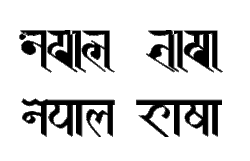Newar language
| Newa | |
|---|---|
| Nepal Bhasa | |
| नेवाः भाय् Newāh Bhāy | |
 The word "Nepal Bhasa" written in the Ranjana alphabet and the Prachalit Nepal alphabet | |
| Native to | Nepal |
| Ethnicity | 1.26 million Newa people (2001 census?)[1] |
Native speakers | 860,000 (2011 census)[2] |
Sino-Tibetan
| |
Early form | |
| Dialects | |
| Ranjana alphabets and various in the past, Devanagari currently | |
| Official status | |
| Regulated by | Nepal Bhasa Academy |
| Language codes | |
| ISO 639-2 | new Nepal Bhasa, Newari |
| ISO 639-3 | Either:new – Newarnwx – Middle Newa |
newa Nepal Bhasa | |
nwx Middle Newa | |
| Glottolog | newa1247 |
Nepal Bhasa is a language spoken by indigenous Newa people of Nepal. It is a Himalayan language of Tibeto-Burman branch of the Sino-Tibetan languages group.
Newah Bhaaye is the term used for Nepal Bhasa by its native speakers. The term 'Newari' has been used in derogatory form to replace the original name of the language. [3]
Linguistics[change | change source]
Nepal Bhasa shares the feature of Kirant and Tibetan dialects of Northern Himalayas. It consists of five major dialects and several sub-dialects spoken by Newa people living throughout the country.
References[change | change source]
- ↑ Newa at Ethnologue (15th ed., 2005)
- ↑ Newa at Ethnologue (18th ed., 2015)
Middle Newa at Ethnologue (18th ed., 2015) - ↑ Kapali, Rukshana (2018-12-08). "Why using the word 'Newari' is problematic". Rukuchee Blog. Retrieved 2018-12-13.[permanent dead link]
Newari edition of Wikipedia, the free encyclopedia
